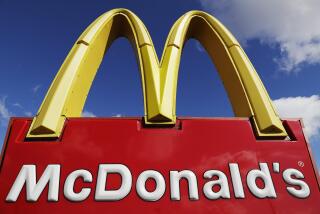Clipping the Coupons : âCents-Offâ Makes Sense to Shoppers
Forewarned, Safeway store manager Richard Meyen was prepared for Joy Mosse: He had special-ordered 17 20-pound boxes of All detergent, briefed his clerks on her arrival and put his most experienced cashier on alert.
At 4 p.m. on a recent weekday at the West Hollywood store, Mosse unfolded her game plan outside the supermarket. Actually, the âplanâ was a carefully crafted shopping list, three pages long, designed to enable her to obtain hundreds of dollars in goods absolutely free (except for sales tax) in exchange for her huge collection of stockpiled coupons.
In her zeal, Mosse may not be typical, but coupons are being clipped in an estimated 80% of U.S. households. Manufacturers are feeding their habit with a cascade of coupons--double the number issued in 1980--and they are worth more than ever. Meanwhile, supermarkets are doubling and even tripling the savings in their own efforts to lure more customers.
Consumersâ Bottom Line
The bottom line for consumers: $2.2 billion last year in discounts, free products and cash rebates for goods ranging from Sony Walkman radios to caviar.
âI donât need to clip the coupons,â explained Mosse, a Beverly Hills resident, âbut itâs a deal, isnât it? Maybe Iâm a shopaholic.â
More likely, a cliptomaniac--and a well-rewarded consumer.
The success of Mosseâs coupon-mining at the West Hollywood store became obvious after two hours of shopping when veteran cashier Georgia Johnson--opening up a closed check stand at manager Meyenâs behest--began working her way through the harvest. Johnsonâs fingers flew over the register keyboard as she rang her way through grocery carts overflowing with paper products, pet food, canned goods, soda pop, deli items and fresh produce--not to mention packages of hamburger, chicken breasts, a beef roast and a pair of steaks.
By the time Johnson had finished, the computerized register chattered out the grand total of $533.25.
$24.12 in Sales Taxes
But with her stack of coupons--some of them doubled because of a Safeway promotion--Mosseâs cost: absolutely nothing for the goods, and just $24.12 in sales tax on the non-grocery items. And she did it using mostly coupons good for free products--not only those offering âcents-offâ discounts. Meyen simply shrugged and smiled. âThereâs no cost to the store,â he explained. âA coupon is just like cash. I make money.â
As Meyen said, coupons are âjust like cash.â And theyâre getting more and more valuable.
Since 1980, the couponsâ average face value increased to 27.3 cents, up 48%. According to a survey by Howard Marlboro Group, the number of coupons valued at 50 cents or more has doubled since 1981, and the New York marketing firm predicted that the average face value will reach 40 cents within five years.
While major manufacturers such as Procter & Gamble, Pillsbury and General Mills--introducing new brands, seeking increased sales or market share in targeted categories--generate most of the coupons, retailers now are upping the ante for coupon-conscious consumers by adding on their own premium.
Indeed, Joy Mosse selected the Safeway market on the West Hollywood-Beverly Hills border precisely because of its advertised offer to double the value of an unlimited number of manufacturersâ coupons up to a face value of $1. Though new to Safeway, the occasional doubling and even tripling of the value of coupons have become increasingly common not only in Southern California but in other such hotly competitive grocery markets as the San Francisco Bay Area, Dallas-Fort Worth and the Chicago and New York metropolitan areas.
âDouble and triple couponing is a merchandising tool that retailers use to get more market share,â explained Karen Brown of the Food Marketing Institute in Washington, a trade group representing 1,500 food wholesalers and retailers.
Product manufacturers reimburse the stores only for the face value of the coupon, plus 7 or 8 cents a coupon in handling fees (which earned the stores $520 million last year).
A recent addition to discounting is alcoholic beverages. Taylor California Cellars offered the first cash rebate on its wines only in May, 1983. It had to survive a legal challenge by the state Department of Alcoholic Beverage Control, which unsuccessfully maintained that the practice was forbidden. In December, 1984, Coors offered a 50-cents-off coupon on six-packs of beer sold in Los Angeles, and some producers of distilled spirits use them, too.
Such rebates are now allowed in 34 states.
Indeed, few grocery items are not couponed these days; even Romanoff Caviar offered one recently (but only for 35 cents off a one-ounce can that usually costs about $16.75).
Thus, Joy Mosseâs coupon coup only underscored the latent value of the colorful chits regularly published in newspapers, magazines and, increasingly, in glossy sheets inserted into such publications. Sunday editions of newspapers have dislodged weekday food sections as the favored distribution vehicle, according to the Food Marketing Institute. (This may not surprise readers who habitually shake their Sunday papers to dislodge a rain of free-standing inserts bearing coupons for an increasingly wide spectrum of goods.)
Except, perhaps, for the total value of what she purchased during her recent foray, Mosse is hardly unique among shoppers. The U.S. Department of Agriculture estimates that 80% of all U.S. households redeem coupons regularly. The department concluded that coupons constitute the fastest-growing form of food advertising, comprising 11% of all revenues spent on promoting food products.
Another avid California coupon clipper is Cheryl Burton, a married Downey resident who is the working mother of a 4-year-old. Burton regularly buys about $70 in grocery products each week but uses coupons to reduce her bill to about $45, she said. By taking advantage of cash rebates, she said she regularly adds about $50 a month to son Stephenâs savings account.
But her annual specialty, she said, is to take advantage of the offer made by several supermarket chains at Thanksgiving to give free turkeys to customers who spend more than, say, $100 that week on groceries in their stores.
âNow that the markets double the value of the coupons, itâs going to be better this year,â Burton predicted. âI should probably do about $200 (in coupons)--and on top of it Iâll get a free turkey!â
Burton estimated that she spends âprobably about a couple hours a week, in odd momentsâ on couponing. Her mother contributes by saving empty packages and register tapes that may be required later as proofs of purchase in obtaining coupons good for free products, redeeming âcents-offâ coupons and obtaining cash rebates.
âI cut them all up and put them in bags, then classify them,â she said.
A similar strategy of collecting packaging from friends and neighbors enabled Mosse to cash in on the offer of free 20-pound boxes of detergent. âPeople give me newspapers and certain boxes,â she said. She also shares and exchanges coupons with a ânetworkâ of about 10 friends, including Burton.
Mosse, a single woman in her 30s who earns her living as a free-lance writer and stand-up comedian at colleges and clubs, estimated her average weekly grocery bill at about $30. Devoting about two hours a week to coupon collecting cuts her cash outlay to about $12, she said.
Such efforts obviously require storage room for filing future âproofs of purchaseâ and stockpiling extra goods. Rolls of paper towels lurk beneath Burtonâs bed, she confessed, despite the fact that her home has a pantry and a laundry cupboard. âI have enough detergent for my grandchildren to be doing laundry,â she said.
Burton, Mosse and other serious coupon-clippers often give away extra products to friends or public aid groups. A San Diego couple, for example, regularly donates dog food--a commonly couponed item--to the animal shelter and extra canned foods to organizations helping the needy. Baskets of collected housewares items make ready gifts for housewarmings and bridal showers.
Dog âEats Wellâ
âWhen I accumulate so many packs of paper plates, say, maybe Iâll do a big barbecue,â Burton said. âYou think of it that way. I have one dog, Honey, a retriever. She eats well.â
Such gung-ho coupon clipping does not faze manufacturers any more than it does retailers, apparently. âOur purpose is being served if the product is used,â said Craig Shulstad, a spokesman for General Mills in Minneapolis. âWe use coupons to try to take business away from someone else in the category or to increase sales volume.â
Procter & Gamble, a major distributor of coupons, recently began running commercials calling attention primarily to coupons it was distributing.
And Pillsbury, another big couponing company, recently experimented with what marketing director Don Osell called âone of the first truly electronic coupons.â Its Burger King subsidiary aired a commercial inviting viewers to draw their own coupons, good for free orders of french fries and soda pop when ordering a hamburger.
Manufacturers are testing machines that dispense coupons in supermarkets. Osell predicted that, once consumers become accustomed to them, the machines will become an important supplementary distribution system. âAfter all,â he said, âif you really want to give a trial to your product, dispensing coupons right there at the point of purchase enables you to reach someone prepared to make a trial.â
Statistics indicate that it is not unusual that Joy Mosse, Cheryl Burton and many other coupon virtuosos throughout the country should stress, as they do, that they do not need to use coupons.
âItâs a Challengeâ
Take the case of Jewell Whitehead of Denham Springs, La. âI really donât need the money,â Whitehead told a reporter recently, âbut everyone has a thing about getting something for nothing. Itâs a challenge to see if you can beat the system.â
The Department of Agriculture reported several years ago that lower-income households are less likely to have access to coupons or to redeem them when they do.
These consumers lacked access, the study said, to perhaps as many as 90% of the coupons distributed through newspapers and magazines. âLower-income consumers spend significantly less for reading materials than those in other groups,â researchers said.
More recently, a Lou Harris Poll conducted for the Food Marketing Institute found that use of coupons clearly increases as household income increases.
The institute tracks coupon trends and collects data on their use. In all of last year, the institute estimates, manufacturers distributed nearly 180 billion coupons with a total face value, if redeemed, of $48.6 billion. Of this ocean of coupons, consumers actually redeem only a fraction--6.5 billion last year. Nonetheless, that amounted to $2.2 billion, the institute said.
The Department of Agriculture study also noted that households that do not use coupons may subsidize those who do. On the one hand, by not redeeming coupons they pay full price for manufacturersâ goods and provide them more revenue for further promotions. And when retailers get into the act by offering to double or triple the face value of coupons, they may also increase prices on non-promoted items to recover part of their cost.
But banning coupons would not likely reduce food costs, according to the Department of Agriculture study, since those funds would simply be channeled into other product development and marketing techniques.
Dedicated clippers like Mosse, Burton and Whitehead are aware that redeeming their coupons can slow lines through the check stand, but they strive to minimize delay by practicing what they call âcoupon etiquetteâ--such things as warning the cashier, organizing the coupons and marking the goodsâ price on the âfreeâ coupons. They also try to shop at off hours. Mosse, for example, said she often shops at 24-hour markets early in the morning on her way to jog.
âIâm Pretty Quickâ
âIâve never really had any run-ins with people behind me--bearing in mind that I donât look behind much,â Burton confessed. âBut most are unbelieving. . . . And Iâm pretty quick. I have everything organized.â
In any case, do not expect consumers to lead a drive to ban coupons--not if Los Angelesâ experience is any indication. When retailers two years ago advertised their willingness to accept one anotherâs âdouble couponsâ then failed to offer any of their own--resulting in none at all--shoppers responded immediately and heatedly.
The retailers quickly apologized and said the blackout was unintended. Thus, Pillsburyâs Don Osell just might be right.
âCoupons are a part of our life style,â he said.
More to Read
Inside the business of entertainment
The Wide Shot brings you news, analysis and insights on everything from streaming wars to production â and what it all means for the future.
You may occasionally receive promotional content from the Los Angeles Times.










